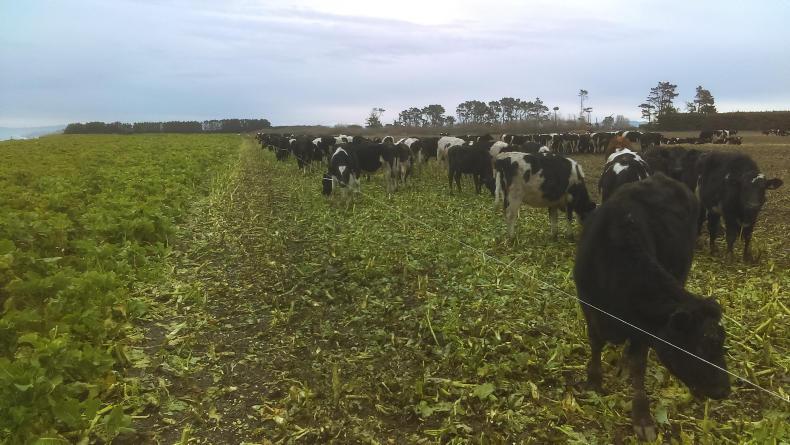My name is Lorna Twomey and I am from Leap in West Cork. I study dairy business at UCD and I am currently on professional work experience at Waimanu Dairy near the town of Ashburton, in mid Canterbury.
I arrived in New Zealand in mid-July, just before the start of the busy spring-calving period.
On this farm, the in-calf heifers or R2s (rising two years old) start calving in mid to late July, with cows calving down from 1 August, which is typical of most New Zealand dairy farms.
The herd here at Waimanu is predominantly Friesian, alongside some Jersey crosses, and all animals are wintered outdoors on kale with silage and minerals supplemented daily.
Differences
The biggest difference between Ireland and New Zealand, in my opinion, is that everything happens outdoors in the paddock here.
There is only one main “shed” on the farm and that is the milking shed. Not a cubicle or slatted shed in sight.
Rain, hail or sunshine, livestock are outdoors 365 days a year.
Cows graze grass during their entire lactation, they are wintered on kale and are transitioned back onto a grass-based diet as they approach calving, and once again return to the rotational grazing system for their next lactation.
Therefore, all calving occurs outdoors in the grass paddocks, with newborn calves collected once daily and their dams drafted out of the calving mob and drafted into the colostrum mob.

A new-born calf suckling its mother in one of the calving mobs
Cows spend four days in the colostrum herd, with heifers spending five. The colostrum is monitored using a colour-coded system (each day it has an assigned colour for both cows and heifers), and every day at the afternoon milking cows with a certain colour tale tape are tested for somatic cell count using the California Milk Test.
Once they have been deemed to have a low SCC, they are drafted out to join the main herd. During the peak calving period as many as 35 cows can calf per day.
Day-to-day duties
My day-to-day duties include milking cows, herding, setting up temporary fences, collecting calves and drafting out cows.
The workload has lightened significantly as the number of cows calved has increased, as there is now less supplement to be fed out.
Cows are milked through a 54-bail Waikato rotary milking parlour and the dairy herd is split into two smaller herds.
There is no specific number of cows that are kept in each herd, and the number will fluctuate depending on grass supply and whether ideal grazing residuals are being achieved.
Cows must graze down to 1500kg DM/ha (which is about 5cm) to ensure a high-quality sward in the next round.
As the calving season recedes, attention is now being focused on the breeding season, which will commence in October.
The breeding season is the fulcrum of the system, in my opinion, because your submission rate will determine your in-calf rate and, ultimately, your production for next year.
Scale and simplicity
The scale and simplicity of New Zealand dairy farming is phenomenal. Big herds of cows are managed on vast areas of land with very little hassle.
The cows do the work when they convert the grass into milk solids. Farmers simply manage them to do this in the most efficient way and then harvest the production.
You work to live, not live to work. You finish at 5pm and that is the day done no matter what.
Helicopter
Also, interesting methods are used to get jobs done. For example, a helicopter was used to apply the first round of chemical fertiliser.
That is something I don’t think I will ever see in Ireland.

A helicopter applying fertiliser to paddocks on the grazing platform in early August
New Zealand is very like Ireland in many ways.
People are very friendly and welcoming, and even though it is more sparsely populated than Ireland, there is still a deep sense of community in the districts and a great value is placed on maintaining strong bonds between neighbours.
It is an absolute privilege to experience New Zealand dairy production on the frontline at the most intense time of the farming calendar.
You can only truly appreciate its scale on the ground and it is something that anyone enthusiastic about dairy farming should experience.
Student blog: milking 4,500 cows in South Dakota
Student blog: it’s time for young farmers to look at how other nations operate
